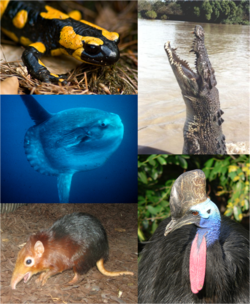Biology:Euteleostomi
| Euteleostomes | |
|---|---|

| |
| Individual organisms from each major Euteleostomi group. Clockwise, starting from top left:
Fire salamander (Amphibia), saltwater crocodile (Reptilia), southern cassowary (Aves), black-and-rufous giant elephant shrew (Mammalia), ocean sunfish (Osteichthyes) | |
| Scientific classification | |
| Domain: | Eukaryota |
| Kingdom: | Animalia |
| Phylum: | Chordata |
| Clade: | Teleostomi |
| Clade: | Euteleostomi |
| Subgroups | |
Euteleostomi (Eu-teleostomi[lower-alpha 1], where Eu- comes from Greek εὖ 'well, good'[lower-alpha 2] or Euteleostomes, also known as "bony vertebrates"[lower-alpha 3]) is a successful clade that includes more than 90% of the living species of vertebrates. Both its major subgroups are successful today: Actinopterygii includes most extant bony fish species, and Sarcopterygii includes the tetrapods.
Euteleostomes originally all had an endochondral bone, fins with lepidotrichs (fin rays), jaws lined by maxillary, premaxillary, and dentary bones composed of dermal bone, and lungs. Many of these characters have since been lost by descendant groups, however, such as lepidotrichs lost in tetrapods, and bone lost among the chondrostean fishes. Lungs have been retained in dipnoi (lungfish), and many tetrapods (birds, mammals, reptiles, and some amphibians). In many ray-finned fishes, lungs have evolved into swim bladders for regulating buoyancy, while in others they continue to be used as respiratory gas bladders.[5][6][7]
Euteleostomi vs. Osteichthyes
In ichthyology the difference between Euteleostomi and Osteichthyes is that the former presents a cladistic view, i.e. that the terrestrial tetrapods evolved from lobe-finned fish (Sarcopterygii). Until recently, the view of most ichthyologists has been that Osteichthyes were paraphyletic and include only bony fishes.[8] However, since 2013 widely cited ichthyology papers have been published with phylogenetic trees that treat the Osteichthyes as a clade including tetrapods.[8][9][10][11] In paleontology, the terms Euteleostomi and Osteichthyes are synonymous.
Classification
Euteleostomi (Osteichthyes) contains the following extinct (✝) and extant taxa:[8]
- Actinistia
- ✝Onychodontida
- Dipnomorpha
- ✝Porolepimorpha
- Dipnoi
- Ceratodontimorpha
- ✝Rhizodontida
- ✝Osteolepidida
- ✝Elpistostegalia
- Tetrapoda
Phylogeny
The following cladogram shows the evolutionary relationships of extant Euteleostomi (Osteichthyes).
| Euteleostomi/ |
| |||||||||||||||||||||||||||||||||||||||||||||||||||||||||||||||
| Osteichthyes |
Notes
- ↑ The name Euteleostomi was coined as a monophyletic alternative that unambiguously includes the living tetrapods and is widely used in bioinformatics.[2]
- ↑ The clade can be defined as the living teleostomes.
- ↑ "Osteichthyes" in the sense of "bony vertebrates" is synonymous with Euteleostomi.[3][note 1]
Subnotes
- ↑ Linnaean taxonomy the name (literally meaning "bony fish") traditionally referred to the paraphyletic group with the exclusion of tetrapods.[4]
References
- ↑ Zhao, W.; Zhang, X.; Jia, G.; Shen, Y.; Zhu, M. (2021). "The Silurian-Devonian boundary in East Yunnan (South China) and the minimum constraint for the lungfish-tetrapod split". Science China Earth Sciences 64 (10): 1784–1797. doi:10.1007/s11430-020-9794-8. Bibcode: 2021ScChD..64.1784Z. https://www.researchgate.net/publication/353479392.
- ↑ Berman, Jules (25 June 2004). Evolution's Clinical Guidebook. Oxford University Press. p. 215. ISBN 0-12-817127-8. https://books.google.com/books?id=MhaVDwAAQBAJ. Retrieved 14 May 2015.
- ↑ Nelson, Joseph (2007). Fishes of the World. John Wiley & Sons. p. 86. ISBN 978-0-471-75644-6. https://books.google.com/books?id=exTV-GLnCB4C.
- ↑ Cracraft, Joel; Donoghue, Michael J. (25 April 2019). Assembling the Tree of Life. Academic Press. p. 396. ISBN 978-0-19-972960-9. https://books.google.com/books?id=6lXTP0YU6_kC&pg=PA396.
- ↑ Clack, Jennifer A. (27 June 2012). Gaining Ground, Second Edition: The Origin and Evolution of Tetrapods. Indiana University Press. pp. 21–4. ISBN 978-0-253-00537-3. https://books.google.com/books?id=4j9AKGsQ1msC&pg=PA23. Retrieved 12 May 2015.
- ↑ Longo, Sarah; Riccio, Mark; McCune, Amy R (2013). "Homology of lungs and gas bladders: Insights from arterial vasculature". Journal of Morphology 274 (6): 687–703. doi:10.1002/jmor.20128. ISSN 0362-2525. PMID 23378277.
- ↑ McCune, Amy R.; C. Schimenti, John (2012). "Using Genetic Networks and Homology to Understand the Evolution of Phenotypic Traits". Current Genomics 13 (1): 74–84. doi:10.2174/138920212799034785. ISSN 1389-2029. PMID 22942677.
- ↑ 8.0 8.1 8.2 Nelson, Joseph S.; Grande, Terry C.; Wilson, Mark V. H. (2016). Fishes of the World (5th ed.). Hoboken: John Wiley and Sons. pp. 96,101. doi:10.1002/9781119174844. ISBN 978-1-118-34233-6.
- ↑ Betancur-R, Ricardo (2013). "The Tree of Life and a New Classification of Bony Fishes". PLOS Currents Tree of Life 5 (Edition 1). doi:10.1371/currents.tol.53ba26640df0ccaee75bb165c8c26288. PMID 23653398.
- ↑ Betancur-R, R., Wiley, E.O., Arratia, G., Acero, A., Bailly, N., Miya, M., Lecointre, G. and Orti, G. (2017) "Phylogenetic classification of bony fishes". BMC evolutionary biology, 17(1): 162. doi:10.1186/s12862-017-0958-3.
- ↑ Hughes, L.C., Ortí, G., Huang, Y., Sun, Y., Baldwin, C.C., Thompson, A.W., Arcila, D., Betancur-R, R., Li, C., Becker, L. and Bellora, N. (2018) "Comprehensive phylogeny of ray-finned fishes (Actinopterygii) based on transcriptomic and genomic data". Proceedings of the National Academy of Sciences, 115(24): 6249–6254. doi:10.1073/pnas.1719358115.
External links
Wikidata ☰ Q1378800 entry
es:Euteleostomi
 |

